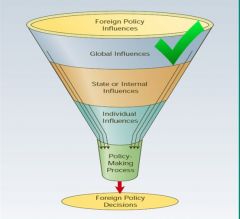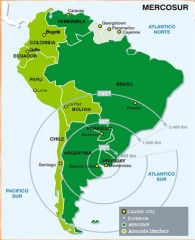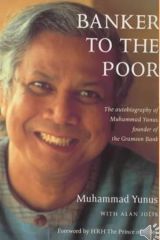![]()
![]()
![]()
Use LEFT and RIGHT arrow keys to navigate between flashcards;
Use UP and DOWN arrow keys to flip the card;
H to show hint;
A reads text to speech;
51 Cards in this Set
- Front
- Back
|
President of China
|
Xi Jinping
-3rd most powerful in the world -Cracked down on dissent. (microblogs, arrested critics of govt) |
|
|
China's Economy
|
GDP to overtake US in 15 years
GDP per capita very low 2 Chinas, coastal vs rural areas A bubble? Cause of Recent stock market drop? Similar to Japan in 80s Authoritarian Capitalism- illusion of capitalism |
|
|
China
Cost of growth Military Soft Power |
Environmental
25% of water polluted Polluted air Largest military(dated tech) Distant Second Olympics, News |
|
|
China Politics
|
Authoritarian Political system- comm party chooses officials.
Authoritarian Capitalism- illusion of capitalism- soviet failed -Gov't runs bank -Dong Pong Ching incorporated capitalism in 80s |
|
|
Global South/North/East
|
Developing countries
advanced industrial countries China & India 80% has only 17% wealth |
|
|
Gross domestic product
|
total value of goods and services produced within a country during a year.
|
|
|
Gross National Income
|
GDP + net income earned from a country's companies and citizens from outside the country.
|
|
|
Purchasing Power Parity
|
Value of GDP or GNI adjusted to reflect the cost of living in a country.
|
|
|
Human Development Index
|
Used to indicate QUALITY OF LIFE within a country
-UN development program -electricity, hunger, life expectancy |
|
|
Semi-Periphery
|
parts of the global south that are doing well
1. Oil Exporting Countries(OPEC) 2. Newly Industrialized Countries(NIC) --Export manufactured goods to the North --Eg. Global East(China, Singapore, Malaysia, S. Korea) |
|
|
Least Developed Countries
|
*Majority in Sub Saharan Africa
-49, 34-African, 9-Asia, 5-Pacific, 1-Carribean |
|
|
(Explanations for Poverty & Inequality)
Millenium Development Goals -Goals? |
-Adopted in 2000 at the UN Millenium Summit
Goals: 1. Eradicate Poverty and Hunger-reduce by half the number of people living on less than 1.25$ a day 2. Achieve UNIVERSAL Primary Education(K-6) 3. Promote Gender Equality and Empower Women-in education and employment. 4. Reduce Chiled Mortality-by 2/3 5. Improve Maternal Health-reduce maternal mortality by 3/4 6. Combat HIV/AIDS, Malaria and Other Diseases-halt and begin to reverse the spread of AIDS and malaria |
|
|
Millenium Development Goals
-Already achieved? -Least progress |
1. Eradicate Poverty and Hunger
-ALREADY achieved -Better in E Asia than Sub Saharan Africa 2. Achieve UNIVERSAL Primary Education(K-6)-Not Yet 3. Promote Gender Equality and Empower Women-Not Yet 4. Reduce Chiled Mortality-Not Yet 5. Improve Maternal Health-Not Yet 6. Combat HIV/AIDS, Malaria and Other Diseases-ALREADY |
|
|
OFficial Development Assistance(ODA)
|
grants or loans to countries from other countries
-0.7% GNI goal |
|
|
Intergovernmental Organizations
|
Institutions created and joined by STATES' governments.
ex. UN |
|
|
United Nations: History
|
a. League of Nations(14pts)
b. Roosevelt and Churchill c. Dunbar Oaks 1944(SU, China, GB, France, US) d. UN Charter Signed in 1945 on Oct 24(effective) |
|
|
UN: Functions
|
All Liberal Ideologies
1. Maintain international peace and provide collective security 2. Promote cooperation in solving social and economic problems(more success) 3. Encourage respect for human rights and fundamental freedoms |
|
|
UN: Organizatial Structure
|
1. General Assembly
2. Security Council 3. Economic and Social Council(ECOSOC) 4. Secretariat 5. International Court of Justice |
|
|
UN: Org. Structure- General Assembly
|
1. Each UN member state gets a vote
2. Most decisions made by majority vote 3. Global South states have a significant majority(G77) 4. Resolutions passed are non-binding. It cannot req state to take action. 5. UN reg budget is determined by General Assembly *US contributes the most(22%) |
|
|
UN: Org. Structure- Security Council
|
1. Responsible for maintaining int'l peace and security
2. 5 *permanent members* with veto power(France, US, Russia, UK, China)Dunbar Oaks 3. Ten non-permanent members elected for 2 year terms by the general assembly 4. Decisions must be approved by 9 of 15 members with no veto(reason it hasn't worked well) |
|
|
UN: Org. Structure- Economic and Social Council(ECOSOC)
|
Coordinates the economic and social work of UN(Big umbrella group overseeing 14 specific programs ie Mill dev goals)
1. 54 member states elected by gen assem for 3 year terms 2. Funding is voluntary, hence wealthier countries are favored |
|
|
UN: Org. Structure- Secretariat
|
Carries out administrative work of UN
-Takes most money 1. Secretary General: Ban Ki Moon --traditionally not of 5 permanent members on UNSC --rotates country |
|
|
UN Secretary General
|
Ban Ki Moon(secretariat)
|
|
|
UN: Org. Structure- International Court of Justice
|
1. Can decide disputes between member state, but only if they agree to participate
2. Issues advisory legal opinions on other legal questions. |
|
|
Evaluating UN: Collective Security
|
Has rarely fullfilled its role of providing for collective security.
-Korean War- because SU was boycotting and Taiwan taking China's seat -1st Persian Gulf War |
|
|
Evaluating UN: Peace Keeping
|
The interposition of military forces from a third party between belligerents to prevent hostilities from escalating
-reduces civil fighting 60%, state/state 85% -Rwanda-failure |
|
|
Evaluating UN: Peace Keeping-Responsibility to Protect-
|
international community should intervene if a state is unable or unwilling to protect its citizens from human rights abuses 2005
-1st used in Libya, Mohmar Kadafi, no fly zone, military action --criticism-poor followup, AU collonialism, Rus+China -Syria- abuses on both sides, syria is stronger. |
|
|
Evaluating UN: Promoting Cooperation
|
Most of the effective work of the UN has been with non-security issues(UNICEF, Dev Prog, WTO, WFP)
|
|
|
Evaluating UN: Agenda Setting
|
Bringing an issue to the attention of political decision makers and he public.
|
|
|
European Union
|
Regional IGO
28 Countries Nobel Peace Prize Speculation- new state system(Hegemon) |
|
|
European Union: Origins
|
1. European Coal and Steel Community 1951
2. Treaties of Rome 1957 3. European Communities(EC) 4. Single European Act 5. Maastricht Treaty 1992 6. Lisbon Treaty 2007, 2009 |
|
|
European Coal and Steel Community
European Union Origins |
1951
1. France and Germany(Italy, Lux, Bel, Neth) 2. Established a common market for trade in coal and steel(Liberalism) |
|
|
Treaties of Rome
European Union Origins |
1957
1. Created 2 institutions: i. European Economic Community-established a common market for a wide range of goods. ii. European Atomic Energy Community-created to promote cooperation in the development of nuclear energy(EURATOM) -became European Communities(EC) |
|
|
Single European Act
European Union Origins |
1. Established the goal of completing the common market by Jan 1, 1993.
2. Provided for free movement of goods, services, capital and *people* |
|
|
Maastricht Treaty *
|
************1992
1. Shift toward political integration** 2. Name changed to European Union 3. Created EU citizenship 4. Pooled Sovereignty-states gives up some of their sovereignty to an IGO. i. For some policy areas, EU is given authority to make decisions that are binding to its member states. eg. Environmental, education, healthcare. 5. Eurozone- Some of the EU countries replaced their state currency with the Euro. 6. European Central Bank-established to manate monetary policy and the euro for Europeans. |
|
|
Lisbon Treaty*
|
2007, 2009
*Like a constitution 1. Expanded Pooled Sovereignty to include new policy areas eg. agriculture, criminal law, immigration. 2. New Position: President of European Council -2.5 year term **Herman Van Rompuy- 1st and current(former PM of Belgium) 3. Allows states to leave the EU |
|
|
Sovereign Debt
|
debt issued or guaranteed by a government
(PIGG) |
|
|
Fiscal Stability Treaty
|
EU
1. If a member state's total debt is greater than 60% of GDP, it must be reduced by a certain percentage each year. 2. Annual budget must be balannced or in surplus. 3. Failure to comply results in financial penalty(0.1% of GDP) *i. UK and Check Republic did not sign *ii. Pattern of varying levels of membership |
|
|
Nongovernmental Organizations
(NGOs) |
Members are *private citizens* from two or more states. Rise due to the internet.
Types: 1. Issue Advocacy Gropus 2. Multinational Corporations 3. Cultural NGOs 4. Terrorist Groups |
|
|
Issue Advocacy Groups
Nongovernmental Organizations (NGOs) |
Transnational interest group organized to influence specific policy areas.
ex. Greenpeace, Amnesty Int'l, Global Fund For Women, IRC, Save the Children Functions: 1. Agenda Setting(ex. Greenpeace, KONY 2012) 2. Education- inform and influence how people view an issue. 3. Representation- Represent groups that cannot represent themselves. 4. Coalition Building- work with gov't leaders to reach int'l agreements. 5. Implementation- help with the implementation of global agreements and monitor compliance. |
|
|
Multinational Corporations
Nongovernmental Organizations (NGOs) |
Business enterprises headquartered in one state, that invest and operate extensively in other states.
|
|
|
Cultural NGOs
Nongovernmental Organizations (NGOs) |
Two Types:
1. Religious Movement- a politically active organization based on strong religious conviction. ex. *Catholic Church* Pope Francis* 1.2b members 2. Ethnopolitical Group- members share a common language, cultural tradition and kinship ties ex. Palestine Liberation Organization(PLO) |
|
|
Terrorist Groups
Nongovernmental Organizations (NGOs) |
Seek to further political objectives through the threat or use of violence.
1. Cultural Terrorist Groups- terrorist group whose members share a common cultural or religious identity. -Cultural NGOs and terrorist groups *Hezbolla- in Lebanon, Shia Islam 2. Ideological Terrorist Group- members share a common political ideology. - Earth Liberation Front (ELF) 3. Crime Syndicates - international drug cartels and mafias *Joaquin Guzman Loera, Sinaloa Drug Cartel, Mexico |
|
|
Dependency Theory
Explanations for Poverty and Inequality |

*Global capitalism* creates an unequal and exploitative international division of labor between Global North and Global South countries
1. Comes from Marxist theory 2. At global/systemic level. Look at structure of int'l econ system 3. Colonial origins, maintained through capitalism - GS is exploited for resources, cheap labor and imports manufactured products. 4. Significant changes to domestic and int'l economic institutions are necessary to achieve greater equality(socialist economic principles) -Hugo Chavez, Daniel Ortega, Raul Castro |
|
|
Modernization Theory
Explanations for Poverty and Inequality |

Developing states are impoverished due to their own *internal characteristics* that impede their economic development.
-State level of analysis 1. Social Characteristics- high illiteracy and low levels of education. 2. Political Characteristics: a. Political instability and conflict b. Corrupt and authoritarian gov't 3. Economic Characeristics: a. Lack of Investment Capital b. Lack of infrastructure and technology c. Lack of ecological resources Solution: Global North can provide the missing components of development, especially *investment capital* -Washington Consensus(strings attached)- Economic growth in the Global South can be best achieved through democracy, free market capitalism, and fiscal discipline(Royal Bank, IMF) |
|
|
Global South Soln's (Poverty/Inequality)
|
1. Commodity Cartel
2. Export-Led Industrialization 3. Regional Trade Regime 4. Micro-finance 5. International Organizations |
|
|
Commodity Cartel
Global South Soln's (Poverty/Inequality) |
“. . . an organization of the producers of a commodity that seeks to regulate the pricing and production of that commodity to increase revenue” (p. 295).
*Organization of Petroleum Exporting Countries (OPEC)-only truly successful example |
|
|
Export-Led Industrialization
Global South Soln's (Poverty/Inequality) |
Economic strategy that promotes the export of manufactured goods.
Global East- China, India, Taiwan, Singapore |
|
|
Regional Trade Regime
Global South Soln's (Poverty/Inequality) |

Promote trade between member states by reducing trade barriers (e.g. tariffs).
*Association of Southeast Asian Nations (ASEAN) *MERCOSUR |
|
|
Microfinance
Global South Soln's (Poverty/Inequality) |

Providing small loans to the poor to help start or expand a small business.
|
|
|
International Organizations
|
Use numerical advantage in international organizations to promote issues important to the developing world.
Group of 77: coalition of Global South countries in the UN General Assembly |

